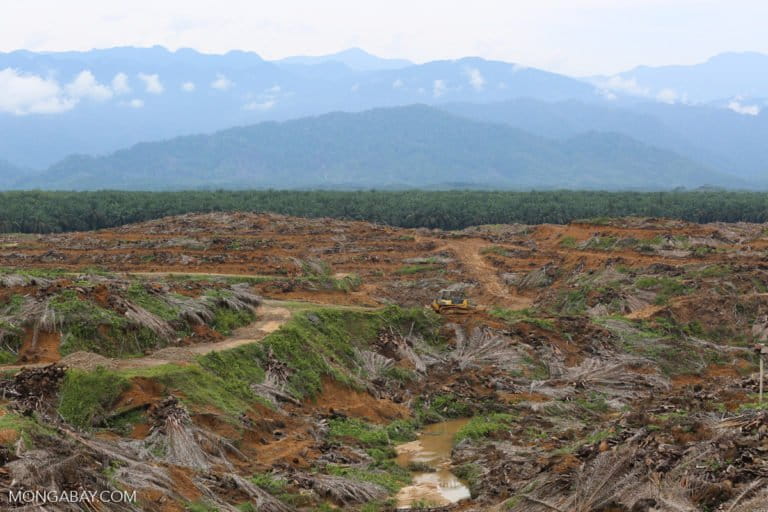- Natural forests store more carbon for longer compared to plantations and agroforestry.
- The carbon sequestration potential of natural forests is 40 times greater than that of plantations, a new analysis has found.
- But countries like Brazil, China and Indonesia are relying more on expanding plantations to meet their regreening goals.
- About 66 percent of forest restoration commitments in tropical and subtropical countries involve planting some kind of agricultural crop.
Forests help mitigate climate change by sucking out carbon dioxide from the atmosphere, locking it away in their trunks and soil. But regreening efforts in many countries rely on the expansion of plantations, where commercially important crops are grown, rather than forest restoration.
This might undercut the gains from forest restoration efforts.
“We understand the economic importance of plantations for many countries,” said Charlotte Wheeler, a forest researcher at the University of Edinburgh and co-author of a recent commentary in Nature. “However, natural forests are the only option that can realistically help mitigate climate change.”
Wheeler, with colleagues at the University of Edinburgh and University College London, examined commitments made by 43 countries in tropical and subtropical regions, where trees grow faster and thus hold greater promise of removing atmospheric carbon.
These countries have pledged as of October 2017 to restore a combined 2.92 million square kilometers (1.13 million square miles) of degraded and deforested land — an area nearly twice the size of Alaska. Some of these are national commitments, while others were made under the Bonn Challenge launched in 2011 by the German government and the International Union for Conservation of Nature (IUCN). The latter initiative aims to restore 3.5 million square kilometers (1.35 million square miles) of degraded and deforested land by 2030 — greater than the size of India.
How much of a dent these commitments will make in removing carbon dioxide from the atmosphere depends on the paths adopted by the countries: whether allowing forests to regrow naturally, through plantations, or through agroforestry.
One of the major reasons plantations are not ideal for carbon storage is that regular harvest and clearing tends to release carbon dioxide every 10 to 20 years. However, natural forests, when left undisturbed, will continue to store the carbon for decades. A conservationist can understand why a monoculture of eucalyptus trees harvested regularly may not qualify as restoration, but the public can be misled by policymakers employing broad definitions of forest restoration, the authors argue.

Many of these plantations are expected to occur in countries like Brazil, China, Indonesia, Nigeria and the Democratic Republic of Congo. In China, almost all (98.8 percent) of the area to be restored will host plantations. In Brazil, it’s just over 80 percent of the targeted restoration area, with only 0.1 percent for natural forests. Indonesia fares a little better with 52 percent of the restoration area designated for plantations and 42 percent for natural forests.
Other countries like Vietnam (85 percent), Mexico (65 percent), India (62.5 percent) and Ethiopia (58.5 percent) have set much higher targets for natural forest restoration.
Taking into account agroforestry, the total area earmarked for growing some kind of crop rises to 66 percent. This, say the authors, is not good news for tackling climate change.
They posited four scenarios for carbon capture if the current commitments for the 3.5 million square kilometers of land under the Bonn Challenge are extended to 2100.
If the entire area is dedicated to natural forests, it would sequester an additional 42 billion tonnes of carbon by 2100. Growing only plantations, however, will store 1 billion tonnes, while exclusive agroforestry will yield 7 billion tonnes in carbon storage. “Maintaining the current reported mix of natural-forest restoration, plantations and agroforestry sequesters about one-third of the carbon” — about 16 billion tonnes — “of the natural-forest-only scenario,” the piece said.

“In terms of conservation it is clear that natural forests are vital for biodiversity conservation,” Wheeler said, adding that “if restoration efforts were planned effectively they could allow for buffer zones or corridors to be created between existing forest patches,” and that “these sort of initiative will be important in the future to allow species to migrate across the landscape, making isolated populations more resilient to climate changes.”
CITATION
Lewis, S. L., Wheeler, C. E., Mitchard, E. T., & Koch, A. (2019). Restoring natural forests is the best way to remove atmospheric carbon. Nature, 568(7750), 25-28.
https://news.mongabay.com/2019/04/natural-forests-best-bet-for-fighting-climate-change-analysis-finds/
No comments:
Post a Comment